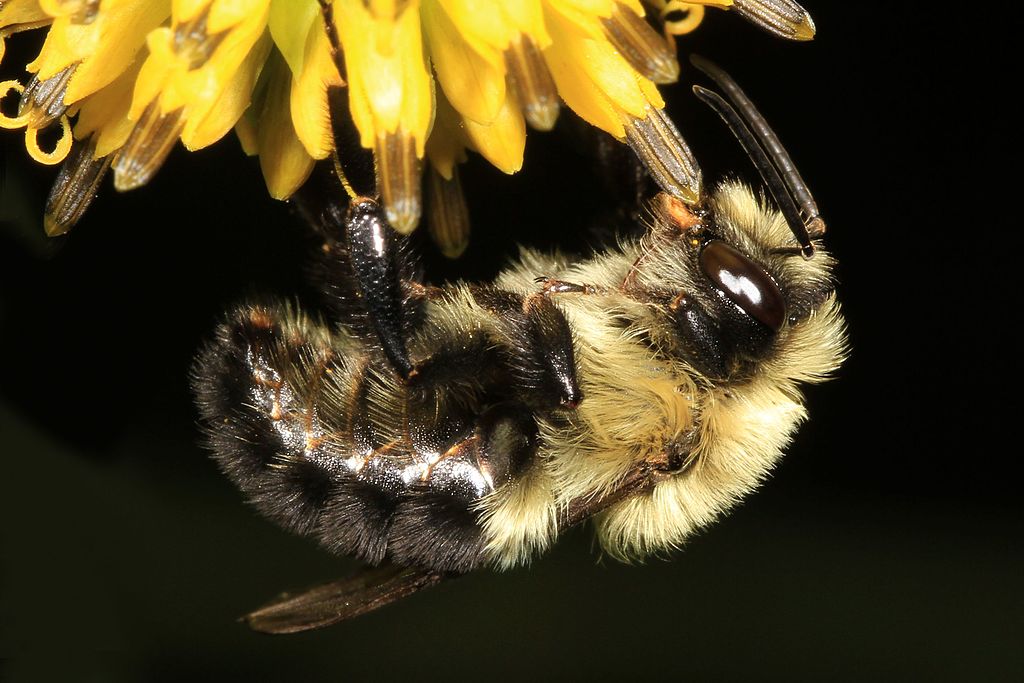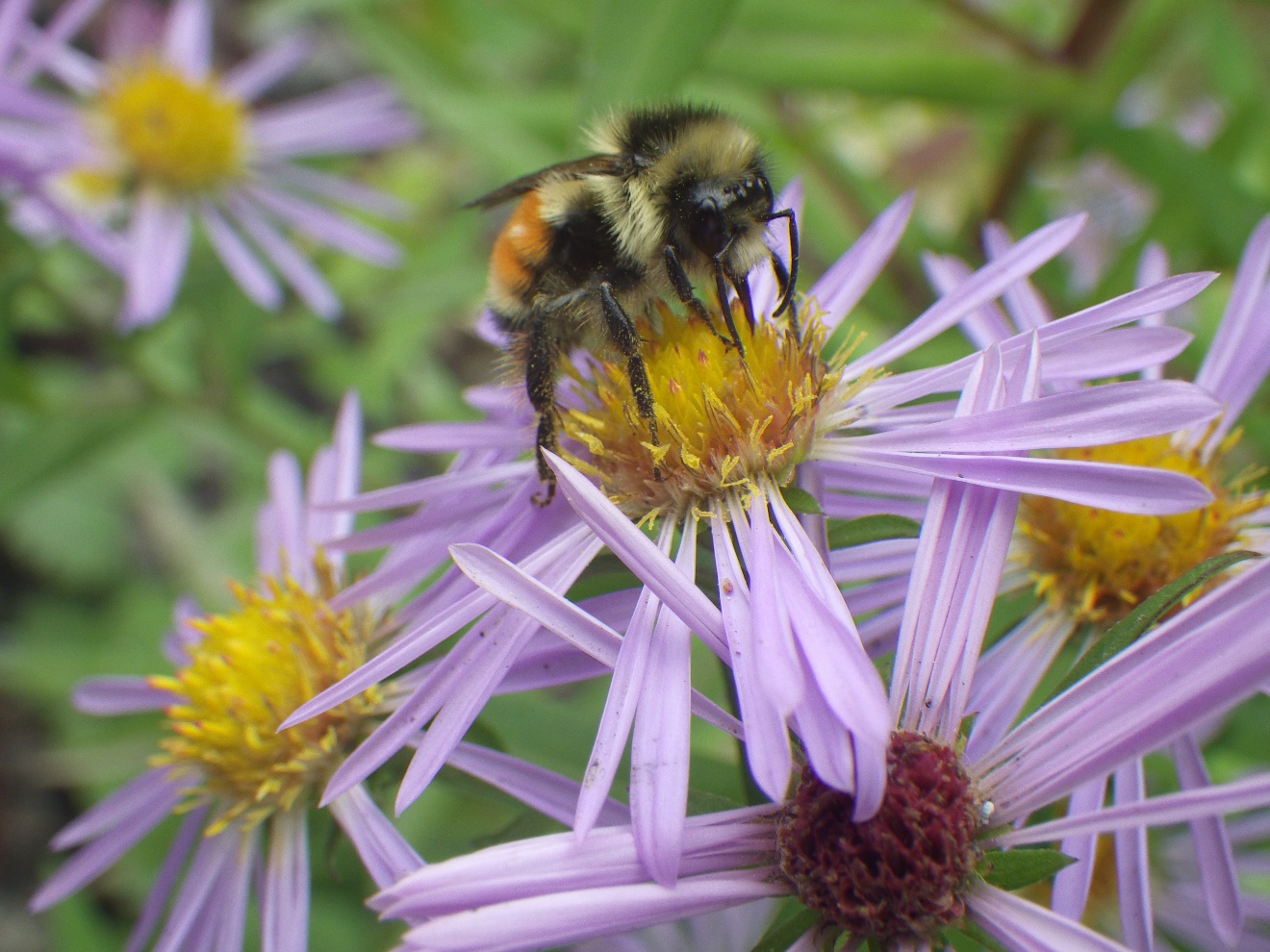By Julie Sircom, Grenfell Campus, Memorial University of Newfoundland
It’s hard to miss the news that Newfoundland’s honey bees are special – Varroa mite, a major pest elsewhere, is absent from the island, and several other diseases have not been found here. Many of the stressors that have led to declines elsewhere aren’t a problem here. Far less is known about the island’s native bees. There are over 70 species, from tiny solitary bees not much larger than an ant to the familiar fuzzy bumble bees. These bees provide a vital and largely unmeasured service, pollinating both crops and native plants. There would be no berry-picking in the autumn if it weren’t for our many native pollinators. Little is known about the health of our native bees, either in terms of the stability of their populations or the types of diseases that affect them.
[pullquote] There would be no berry-picking in the autumn if it weren’t for our many native pollinators.[/pullquote]
The Canadian Environmental Law Association (www.cela.ca) defines the precautionary principle as the duty to do whatever we can to prevent harm, whether or not we have all of the evidence. In the case of Newfoundland’s pollinators, both the native species and the managed honey bees, this means avoiding the possible introduction of pests, disease, and alien species. There are two main ways this might happen: imports of honey bees and related equipment, and imports of the commercially-reared bumble bee Bombus impatiens. There are regulations regarding both, but the latter is seen as less of a threat, based on a number of assumptions.
Although imports of bumble bees were allowed in the past, no permits have been issued in recent years. Due to earlier imports, B. impatiens is currently considered to have low environmental risk. It has been assumed that the bees are disease-free as they are reared in a controlled environment and are not thought to share diseases with honey bees. The commercial nests are also equipped with queen excluders that are designed to prevent queens from leaving the nests and establishing new colonies. Furthermore, B. impatiens is a more southerly species and it is assumed that any escapees would be unable to survive Newfoundland’s harsher winters. All of these turn out to be questionable assumptions.

Import permits for B. impatiens have not been issued recently due to rising concern about the potential impact on local bees. Commercially-reared bumble bees have been shown to carry a number of parasites and diseases. These are almost certainly capable of infecting native bees, which may not have the defences to fight such infections. In addition, some of these pathogens are shared with honey bees. Parasite and disease transfer between B. impatiens and other bees is very simple: bees repeatedly visit the same flower as its nectar reserves are replenished. An infected bee can leave behind ‘hitchhikers’ that survive until the next bee visits the flower. Bees also visit other nests more frequently than you might imagine. If a native bee enters a B. impatiens nest to rob a little nectar, it can very easily become infected.
It is also clear that B. impatiens can overwinter in Newfoundland. Bumble bee nests die off at the end of the season, and only new queens overwinter. In 2015, B. impatiens was imported for supplemental pollination on a cranberry farm in Western Newfoundland. To the best of my knowledge, these were ‘used’ bees, from lowbush blueberry crops in Nova Scotia or New Brunswick. This is obviously of concern, as they would have been exposed to a range of parasites and diseases in those fields. These nests either were not equipped with queen excluders because B. impatiens is native to the Maritime provinces, or were damaged; either way, an unknown number of queens escaped. In May and June 2016, I collected 24 B. impatiens queens on the farm. These must have come from the commercial nests imported the previous year; no B. impatiens were recorded in any other sampling location.
[pullquote]But what would happen if B. impatiens were to become established in Newfoundland? [/pullquote]
So far, there is no sign that any of the queens successfully established a nest, but searching for a newly-established species is like looking for a needle in a haystack. But what would happen if B. impatiens were to become established in Newfoundland? Would it really matter? We don’t know, so the precautionary principle dictates that we do our best to avoid it happening.
One possible outcome is the displacement of native species. The queens of B. impatiens are larger than many of our native bees, and in 2016 they emerged early in the season. This raises the possibility of these queens establishing nests in prime locations before some native bees are even active, and usurping nesting sites from smaller native bees that are active at the same time. This includes one of the most abundant species, at least in Western Newfoundland, B. ternarius. This is a distinctive bumble bee with a broad orange band on its abdomen.

A pragmatist might ask why this matters, as long as there are bumble bees to perform the task of pollinating. However, if B. impatiens were to dominate the bumble bee community, important ecological resiliency would be lost. Our diverse native bee community is adapted to local conditions and provides insurance against our often unpredictable weather. If B. impatiens populations crashed, there may be few species to take up the slack. If parasites and diseases carried by these bees were passed to honey bees and led to colony losses, they would be unable to fill the pollination needs of agriculture. There are many other unknowns with regards to the extent of environmental effects of introduced B. impatiens. For example, I collaborated with Barry Hicks (College of the North Atlantic, Carbonear), on a study in Western Newfoundland that suggested that B. impatiens was a less efficient pollinator than native bees.
If Newfoundland is to preserve the special status of its honey bees, and protect its native pollinators, the precautionary principle must be applied. It is tempting to take the easy route that claims to provide reliable pollination and consistent crop yields, but we should have greater faith in our own resources. A few simple farming techniques, such as maintaining native flowering plants on field margins, can ensure a diverse and abundant pollinator community. Meanwhile, my research team and collaborators can continue to collect the missing evidence that will allow us to make informed choices about whether we need supplemental pollination, and how best to deliver it if we do.
